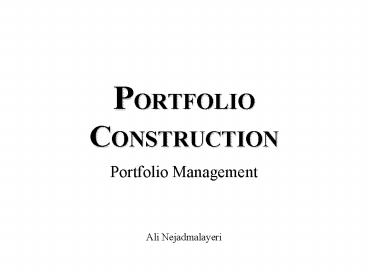PORTFOLIO CONSTRUCTION PowerPoint PPT Presentation
1 / 21
Title: PORTFOLIO CONSTRUCTION
1
PORTFOLIO CONSTRUCTION
- Portfolio Management
- Ali Nejadmalayeri
2
Portfolio Construction
- Given a set of selected Securities
- Finding Appropriate Asset Weights
- Optimizing the Portfolio
- Highest Return for a Given Level of Risk
3
Optimal Portfolio
- Define the Risk Level
- Given the set of assets, Find the Bundle that
Maximizes the Portfolio Return (Markowitz
Optimization) - Define Measures of Return and Risk
- Account for the Covariation of Asset Returns
- Maximize Portfolio Return, or Minimize Portfolio
Risk
4
Risk and Return
- In finance, we ALWAYS perceive everything in a
forward looking way so - Return and Risk are Expected Measures
- Q How Does One Make Up Expectation about Future
Return and Risk? - A Either History tells, or a Model Defines
5
How Construct EF?
- With Historical Information
- 1st, find asset returns from prices
- 2nd, find return on an equally weighted portfolio
- 3rd, find the average and std. dev. of returns
for the portfolio - 4th, use SOLVER to determine that given a level
of return, what are the variance minimizing
weights
6
Historical Measures Return
- Ordinary we know of transaction prices, so
- If Pbeg and Pend are price of an asset at the
beginning and end of an unit period of time, say
one month, and CF is the additional cash flow
payment to holders of the asset at the end of the
period, then
7
Expected Return by History
- Lets assume for T period we know that returns
are given R1, , RT, then Expected Return, E(R),
is
8
Risk by History
- Ordinary we measure risk with variance, Var(R).
Lets assume for T period we know that returns
are given R1, , RT, then Risk (variance),
Var(R), is
9
How Construct EF?
- With Non-Historical Expectations
- 1st, use the correlation (variance-covariance)
structure, find average and std. dev. of returns
for the portfolio - 2nd, use SOLVER to determine that given a level
of return, what are the variance minimizing
weights
10
Covariation by History
- Ordinary we measure covariation with covariance,
Cov(R) and correlation, Corr(R). Lets assume
for T period we know that returns for two assets
are given asset X RX1, , RXT, and asset Y
RY1, , RYT then Covariance, Cov(R), is - the Correlation, Corr(R), is
11
Portfolio Variance
- Say we have N assets with N expected returns of
E(R1), , E(RN), N variances of Var(R1), ,
Var(RN), and N ? N pairs of correlations, r1,1,
, ri,j,, rN,N. Then the variance of portfolio
with weights of w1, , wN is given
12
Implementation1st, Set-up the Problem
13
Implementation2nd, Simplify Correlations
14
Implementation3rd, Weights ? Stdevs
15
Implementation4th, Weights ? Stdevs ? Corr.s
16
ImplementationLast, Sum All Elements
17
Review of Portfolio Theory
- Effect of Covariation
- For an equally weighted portfolio of two assets
with expected returns of 12 and 22, and
variances of 0.25 and 0.50, then -
18
Review of Portfolio Theory
- Effect of Weights in Reducing Risk
- For an equally weighted portfolio of two assets
with expected returns of 12 and 22, and
variances of 0.25 and 0.50, then the global
minimum variance portfolio is -
19
Review of Portfolio Theory
- Weights and Conditional Risk Reduction
- For an equally weighted portfolio of two assets
with expected returns of 12 and 22, and
variances of 0.25 and 0.50, then for the required
return of 17 the minimum variance portfolio is -
20
Market Risk
- As we add more stocks to a portfolio the share of
idiosyncratic risk decreases, and total risk
approaches market risk
Idiosyncratic (Non-Systematic, Diversifiable) Risk
Market (Non-Diversifiable) Risk
Total Risk
21
Efficient Frontier

